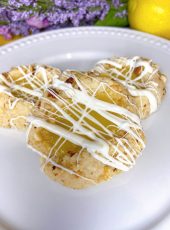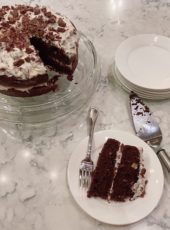From German and Danish roots of eating a little something sweet alongside their bitter coffee, this recipe is a delicate, elegant evolution of a classic.
JERRY: Gina, do you know what a Drake’s Coffee Cake is?
GINA: Of course, the plane cake with the sweet brown crumbs on the top.
– Seinfeld (Season 3, Episode 15)
In some cultures, a coffee cake may actually be a cake flavored with coffee. The British version, for example, is two layers of coffee-infused sponge cake with a coffee buttercream icing – which sounds amazing. In the United States, though, coffee is conspicuously absent from our coffee cakes. Instead, ours tend to be single layer unfrosted cakes meant to be eaten alongside coffee, either as a brunch treat or a casual dessert. Writing for Sprudge, Zac Cadwalader calls the heavenly combination of sweet cake and bitter coffee “sensorial alchemy.”
As he explains, coffee cake doesn’t exactly have an origination point. But like many American foods, it has an evolution. Cakes more broadly have existed since biblical times, at that time heavy on honey, dates, and other fruits. Most agree that coffee cake originated among Northern and Central Europeans and came to America with German and Danish immigrants, who were accustomed to eating a small sweet with coffee (e.g. a Danish!) The term itself doesn’t appear until 1850, where a character in The Gift by Virginia de Wyze refers to heading to the kitchen to “make the tea and cut the coffee cake.”
It’s about 20 to 30 years after that, according to Foodimentry, that coffee cake became a household name, and by then it had evolved from a yeast-raised, bread-like treat (e.g. a Danish!) into a more classic cake. From there they expand in all kinds of directions – they may be loaf-shaped, baked in a Bundt or tube pan, or in a springform pan (like this one). They may have no topping, a glaze, or a crumb topping. In a blog post titled “Crumb Cake: An Extremely Opinionated Education” Jessie Unicorn Moore passionately writes that people outside the Northeast have no idea what crumb cake is or what it should be.
As far as I understand the two major premises of Moore’s argument: (1) the ratio should be half cake to half crumb topping – sold; (2) streusel is not a crumb topping – also sold. At first I bristled on the second matter. Streusel feels part and parcel to coffee cake to me – it’s even a German word that means “sprinkle” – cute, in addition to being apropos. But they are different. Streusel is typically cold butter cut in with flour and white sugar; crumb topping is typically melted butter mixed with flour, brown sugar, and cinnamon. A streusel topping does not make a crumb cake, but it does satisfy a broader definition of a coffee cake. Moore also asserts that New York in particular is the epicenter of the perfect crumb cake. Coffee cakes do make me think of New York City delis and bakeries, which makes sense given the city’s place in the culinary history of readymade foods.
Actually, coffee cake is strangely emblematic of the shifts in American food choices that corresponded with modernization and industrialization. For example, coffee cakes became even more popular in American cuisine with the expansion of refrigeration in the 1930’s; before then there wasn’t easy access to sour cream, a key ingredient that activates baking soda to act as a leavening agent. But before then, coffee cakes were a staple of readymade food purchases at the turn of the 20th century.
As Katherine Leonard Turner writes in the journal Food, Culture, & Society, food historians generally accept that by the 1960’s middle class Americans had cemented their interest in purchasing readymade foods, romanced by the glamor of national ad campaigns and the ease of this new convenience. But this focus obscures another food history truth: from the late 1800’s onward, densely populated American cities began offering local readymade foods to the working class. This facet of urban economies may not have been as glamorous, but it served a need: offering inexpensive foods to laborers who lacked time to make at-home foods. It’s in the period that coffee cakes’ popularity expanded that bakeries proliferated in America’s industrial centers. Turner offers, “in 1879 there were 6,396 bakeries in the United States, roughly one for every 7,800 Americans. By 1909 there were 23,926 bakeries, or one for every 3,800 people. In short, there were twice as many bakeries per capita in 1910 as in 1880.” Surely coffee cakes are just a piece of that history, but they’re a sweet slice, nonetheless. And since these bakeries, as Turner explains, were primarily operated by German and Jewish immigrants, it’s safe to say that coffee cakes were a staple in them.

Coffee cake is an iconicly American thing: it evolved from immigrants, it enjoys controversial debate about its best version, and it’s a no-nonsense inexpensive treat that has fueled the bodies of hardworking laborers. And this recipe from Vera at omgchocolatedesserts.com is my very favorite recipe of all time. I’ve made it for countless holidays and gifts, and everyone I’ve shared it with absolutely loves it. By the way, April 7th – my mother’s birthday! – is also National Coffee Cake today, a perfect excuse to try this recipe.
Raspberry Cream Cheese Coffee Cake
Recipe by Vera @ omgchocolatedesserts.comCourse: BrunchDifficulty: Easy8-12
servings40
minutes40
minutesIngredients
- For the filling
8 oz cream cheese, softened
1/4 cup sugar
1 egg white
1 cup fresh raspberries, washed and well drained
- For the cake
1 1/2 cups all purpose flour
1/2 tsp baking powder
1/2 tsp baking soda
1/4 tsp salt
5.5 TBSP unsalted butter, softened
1/2 cup sugar
1 egg + 1 egg yolk
3/4 cup sour cream
1 tsp vanilla extract
- For streusel topping
3 TBSP butter, cold and cubed
1/2 cup all purpose flour
1/3 cup sugar
Directions
- Preheat oven to 350F; grease a 9-inch springform pan and set aside.
- To make the filling: Mix together the cream cheese and sugar on medium-low speed until creamy. Add egg white and mix on low just to combine. Set aside.
- To make the cake batter: In a bowl stir together flour, baking powder, baking soda and salt, set aside.
- With an electric mixer cream together the butter and sugar on medium-low speed. Add egg and egg yolk and vanilla. Slowly mix in the flour mixture alternating with the sour cream. Transfer the batter into the prepared pan and smooth with a spatula. Spread the cream cheese filling on top. Place raspberries onto cream cheese filling.
- To make the topping: Combine sugar, flour and chilled cubed butter in a bowl. Stir with a fork or pastry blender until the mixture is crumbly.( Make sure the streusel is in pea-sized crumbs)
- Sprinkle the streusel on top of raspberries.
- Bake for 40-45 minutes until a cake tester inserted in the center comes out clean. Cool on a rack, run a thin knife around the cake and loose ring of springform pan.





